Analysis of HACCP: Food Safety, ISO 9001, BRC Standards & PRPs
VerifiedAdded on 2023/04/24
|10
|3293
|496
Report
AI Summary
This report discusses food safety management, focusing on HACCP principles, ISO 9001:2015, and BRC standards. It emphasizes the importance of a preventive approach to reduce food-borne hazards. The report details the seven principles of HACCP, highlighting their benefits in food management. It also examines the role of prerequisite programs (PRPs), specifically pest control and personal hygiene, in maintaining food safety. Pest control is presented as a critical component of GMP compliance, while personal hygiene is crucial for preventing food contamination by handlers. The report concludes that effective implementation of HACCP and PRPs is essential for ensuring food safety and quality.
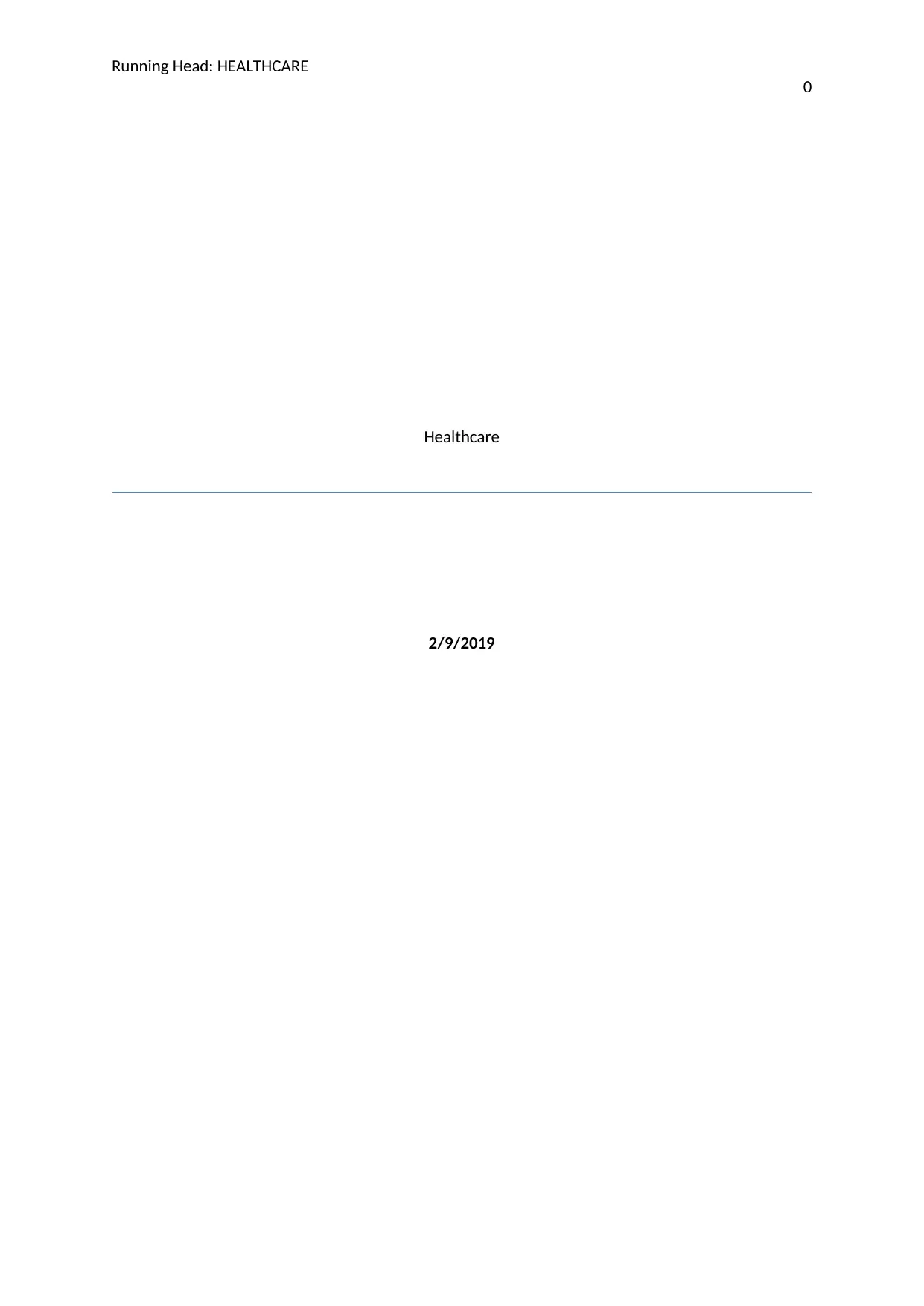
Running Head: HEALTHCARE
0
Healthcare
2/9/2019
0
Healthcare
2/9/2019
Paraphrase This Document
Need a fresh take? Get an instant paraphrase of this document with our AI Paraphraser

HEALTHCARE
1
Contents
Introduction...........................................................................................................................................3
Concept of food management and HACCP principles...........................................................................3
ISO 9001:2015..................................................................................................................................5
BRC standards for food safety...........................................................................................................5
Pre-requisite programmes (PRPs)..........................................................................................................6
Significance of the PRPs in food safety management............................................................................6
Importance of Pest control in food safety..........................................................................................6
Pest control in design and maintenance of HACCP plan...................................................................7
Importance of /Personal hygiene.......................................................................................................7
Personal hygiene in design and maintenance of a HACCP plan........................................................8
Conclusion.............................................................................................................................................8
References.............................................................................................................................................9
1
Contents
Introduction...........................................................................................................................................3
Concept of food management and HACCP principles...........................................................................3
ISO 9001:2015..................................................................................................................................5
BRC standards for food safety...........................................................................................................5
Pre-requisite programmes (PRPs)..........................................................................................................6
Significance of the PRPs in food safety management............................................................................6
Importance of Pest control in food safety..........................................................................................6
Pest control in design and maintenance of HACCP plan...................................................................7
Importance of /Personal hygiene.......................................................................................................7
Personal hygiene in design and maintenance of a HACCP plan........................................................8
Conclusion.............................................................................................................................................8
References.............................................................................................................................................9
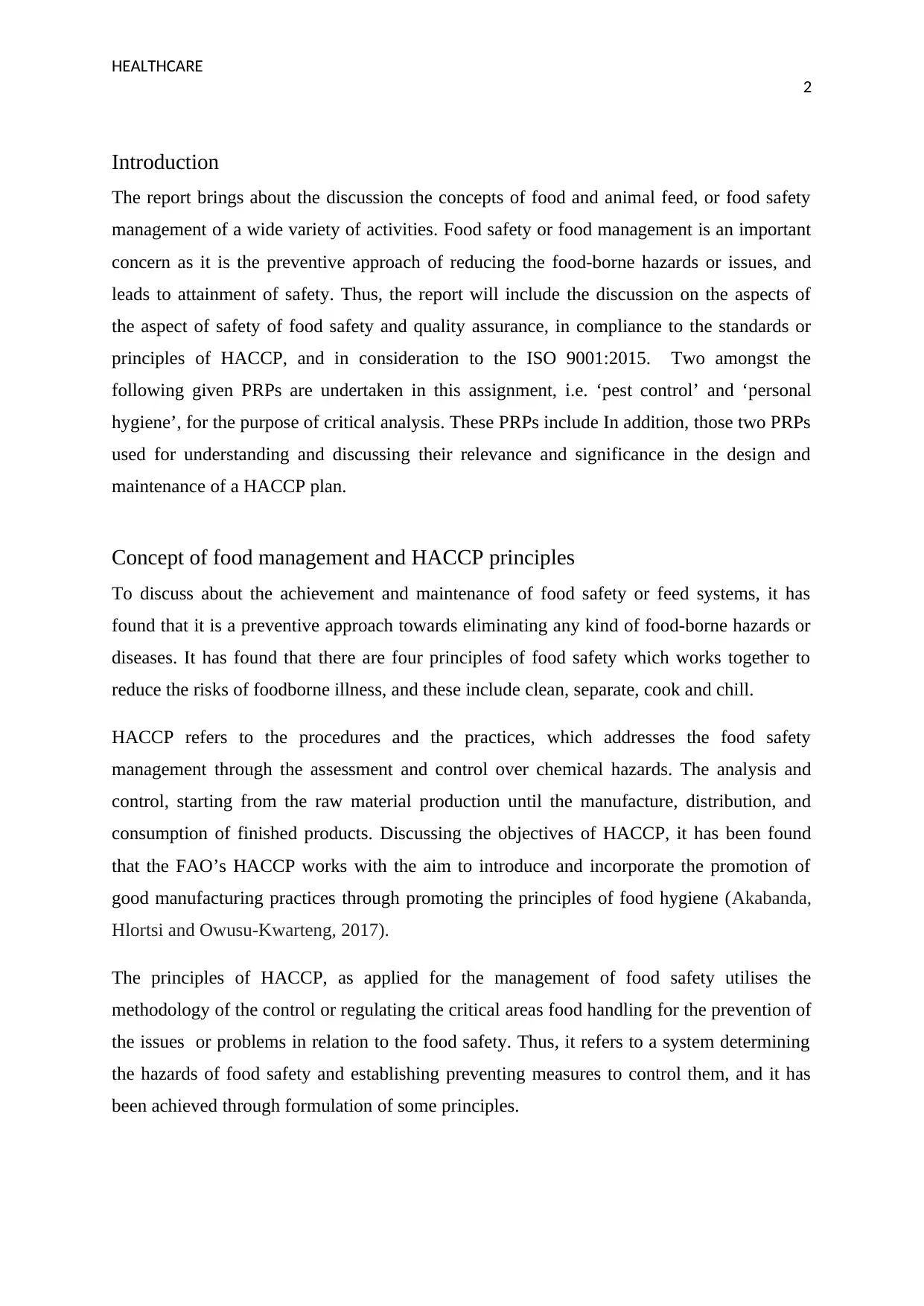
HEALTHCARE
2
Introduction
The report brings about the discussion the concepts of food and animal feed, or food safety
management of a wide variety of activities. Food safety or food management is an important
concern as it is the preventive approach of reducing the food-borne hazards or issues, and
leads to attainment of safety. Thus, the report will include the discussion on the aspects of
the aspect of safety of food safety and quality assurance, in compliance to the standards or
principles of HACCP, and in consideration to the ISO 9001:2015. Two amongst the
following given PRPs are undertaken in this assignment, i.e. ‘pest control’ and ‘personal
hygiene’, for the purpose of critical analysis. These PRPs include In addition, those two PRPs
used for understanding and discussing their relevance and significance in the design and
maintenance of a HACCP plan.
Concept of food management and HACCP principles
To discuss about the achievement and maintenance of food safety or feed systems, it has
found that it is a preventive approach towards eliminating any kind of food-borne hazards or
diseases. It has found that there are four principles of food safety which works together to
reduce the risks of foodborne illness, and these include clean, separate, cook and chill.
HACCP refers to the procedures and the practices, which addresses the food safety
management through the assessment and control over chemical hazards. The analysis and
control, starting from the raw material production until the manufacture, distribution, and
consumption of finished products. Discussing the objectives of HACCP, it has been found
that the FAO’s HACCP works with the aim to introduce and incorporate the promotion of
good manufacturing practices through promoting the principles of food hygiene (Akabanda,
Hlortsi and Owusu-Kwarteng, 2017).
The principles of HACCP, as applied for the management of food safety utilises the
methodology of the control or regulating the critical areas food handling for the prevention of
the issues or problems in relation to the food safety. Thus, it refers to a system determining
the hazards of food safety and establishing preventing measures to control them, and it has
been achieved through formulation of some principles.
2
Introduction
The report brings about the discussion the concepts of food and animal feed, or food safety
management of a wide variety of activities. Food safety or food management is an important
concern as it is the preventive approach of reducing the food-borne hazards or issues, and
leads to attainment of safety. Thus, the report will include the discussion on the aspects of
the aspect of safety of food safety and quality assurance, in compliance to the standards or
principles of HACCP, and in consideration to the ISO 9001:2015. Two amongst the
following given PRPs are undertaken in this assignment, i.e. ‘pest control’ and ‘personal
hygiene’, for the purpose of critical analysis. These PRPs include In addition, those two PRPs
used for understanding and discussing their relevance and significance in the design and
maintenance of a HACCP plan.
Concept of food management and HACCP principles
To discuss about the achievement and maintenance of food safety or feed systems, it has
found that it is a preventive approach towards eliminating any kind of food-borne hazards or
diseases. It has found that there are four principles of food safety which works together to
reduce the risks of foodborne illness, and these include clean, separate, cook and chill.
HACCP refers to the procedures and the practices, which addresses the food safety
management through the assessment and control over chemical hazards. The analysis and
control, starting from the raw material production until the manufacture, distribution, and
consumption of finished products. Discussing the objectives of HACCP, it has been found
that the FAO’s HACCP works with the aim to introduce and incorporate the promotion of
good manufacturing practices through promoting the principles of food hygiene (Akabanda,
Hlortsi and Owusu-Kwarteng, 2017).
The principles of HACCP, as applied for the management of food safety utilises the
methodology of the control or regulating the critical areas food handling for the prevention of
the issues or problems in relation to the food safety. Thus, it refers to a system determining
the hazards of food safety and establishing preventing measures to control them, and it has
been achieved through formulation of some principles.
⊘ This is a preview!⊘
Do you want full access?
Subscribe today to unlock all pages.

Trusted by 1+ million students worldwide

HEALTHCARE
3
Principle 1: The first principles begin from the identification of all potential hazards at
all the stages, i.e. from the growth, manufacturing, processing, and distribution to the
level of consumption. In addition, it also includes assessing about the occurrence of
hazards and establishing preventive measures for their control.
Principle 2: It includes determination of the points, procedures, and practices which
can be utilised to control the hazards, and these points are referred to as CCP (Critical
control points), or to reduce the occurrence of risks of hazards.
Principle 3: The third principles states about establishing critical limits met for
purpose of ensuring that CCPs are under-control (Yin et al., 2017).
Principle 4: Establishing the system to analyse or exert control of the CCPs using
established observations or testing.
Principle 5: identifying and analysing the variation, and ensure taking corrective
measure or action if any particular CCP is not under control.
Principle 6: The sixth principle determines the application and establishing the
procedures for the purpose of verification through supplementary tests and
procedures. These tests and procedures confirm or determine the effectiveness of the
working of HACCP.
Principle 7: The last principle in the HACCP or the food safety management system
concerns all the practices and records, which are considered suitable for the use
formulated principles and their usage (Food safety and quality, 2018).
From the above-mentioned principles of HACCP, it has understood that there are numerous
benefits of incorporating these principles within any food management business. The
advantages of HACCP consist of the efficient use of resources along with the response on
time to other food safety problems.
To be more specific, the RSPH’s level 3 has been one element, which has linked to the
HACCP practices. The RSPH’s level 3 qualification has been associated with the food
manufacturing or animal food manufacturing states the importance of HACCP based feed
safety management procedures, and also aims to establish the corrective action for the
purpose of evaluation (Kharub, Limon and Sharma, 2018).
To attain and maintain high levels of food safety, through the implementation of PRPs,
organisations must adhere to the national or international food laws or rules. Food laws refer
to collection of laws, and regulations, which govern the production of food, distribution, and
3
Principle 1: The first principles begin from the identification of all potential hazards at
all the stages, i.e. from the growth, manufacturing, processing, and distribution to the
level of consumption. In addition, it also includes assessing about the occurrence of
hazards and establishing preventive measures for their control.
Principle 2: It includes determination of the points, procedures, and practices which
can be utilised to control the hazards, and these points are referred to as CCP (Critical
control points), or to reduce the occurrence of risks of hazards.
Principle 3: The third principles states about establishing critical limits met for
purpose of ensuring that CCPs are under-control (Yin et al., 2017).
Principle 4: Establishing the system to analyse or exert control of the CCPs using
established observations or testing.
Principle 5: identifying and analysing the variation, and ensure taking corrective
measure or action if any particular CCP is not under control.
Principle 6: The sixth principle determines the application and establishing the
procedures for the purpose of verification through supplementary tests and
procedures. These tests and procedures confirm or determine the effectiveness of the
working of HACCP.
Principle 7: The last principle in the HACCP or the food safety management system
concerns all the practices and records, which are considered suitable for the use
formulated principles and their usage (Food safety and quality, 2018).
From the above-mentioned principles of HACCP, it has understood that there are numerous
benefits of incorporating these principles within any food management business. The
advantages of HACCP consist of the efficient use of resources along with the response on
time to other food safety problems.
To be more specific, the RSPH’s level 3 has been one element, which has linked to the
HACCP practices. The RSPH’s level 3 qualification has been associated with the food
manufacturing or animal food manufacturing states the importance of HACCP based feed
safety management procedures, and also aims to establish the corrective action for the
purpose of evaluation (Kharub, Limon and Sharma, 2018).
To attain and maintain high levels of food safety, through the implementation of PRPs,
organisations must adhere to the national or international food laws or rules. Food laws refer
to collection of laws, and regulations, which govern the production of food, distribution, and
Paraphrase This Document
Need a fresh take? Get an instant paraphrase of this document with our AI Paraphraser

HEALTHCARE
4
consumption. For an example, the administration of the food and drug regulates the
production of the bottled water (Salemdeeb et al., 2017).
ISO 9001:2015
It defines about the attainment, and maintenance of the food safety, through implementing the
quality management systems. A quality management system (QMS) refers to the collective
work of the businesses, which are focused upon meeting the requirements of the customers,
and leading to high customer satisfaction (Tzamalis, Panagiotakos and Drosinos, 2016). The
quality management system (QMS) has aligned and linked to an organisation’s purpose and
strategic direction, i.e. (ISO 9001:2015) for the objective of achieving food safety.
ISO 9001:2015, International standards for organisation defines the standard determining the
quality using a quality management system, and is the only certified standard in the system.
According to the research findings, on the food safety management it has found that over one
million companies certified to the standards of ISO 9001:2015 (International standard for
organisation, 2018). Thus, discussing the objective of an organisation using these standards is
that ISO ensures the ability to provide goods and services, as per the customer requirements.
In addition, it also aims to enhance the levels of customer satisfaction through the
implementation of improvement processes or systems within their operations. Thus, it has
been analysed that HACCP, QMS (ISO9001:2015), food or feed law are considered as the
methods leading to the attainment and maintenance of high levels of food safety (Alli, 2016).
From the above discussion, the readers will gain an understanding about the role of HACCP,
food or feed laws, and their contribution towards assuring food safety. Now, the following
section will mention the relevance and importance of two PRP’s in the design and
implementation of HACCP plan.
BRC standards for food safety
For attaining an optimum level of food safety, it has found that BRC (British retail
consortium) standards for the food safety have established. It is a trade association, which has
created in the year 1992, for the UK food industry, has published standards for the food
industry. It operates with the objectives of ensuring and maintaining the food or product
safety culture, and serves as to be one major requirement documented in the HACCP plan
(BRC global standards, 2018).
4
consumption. For an example, the administration of the food and drug regulates the
production of the bottled water (Salemdeeb et al., 2017).
ISO 9001:2015
It defines about the attainment, and maintenance of the food safety, through implementing the
quality management systems. A quality management system (QMS) refers to the collective
work of the businesses, which are focused upon meeting the requirements of the customers,
and leading to high customer satisfaction (Tzamalis, Panagiotakos and Drosinos, 2016). The
quality management system (QMS) has aligned and linked to an organisation’s purpose and
strategic direction, i.e. (ISO 9001:2015) for the objective of achieving food safety.
ISO 9001:2015, International standards for organisation defines the standard determining the
quality using a quality management system, and is the only certified standard in the system.
According to the research findings, on the food safety management it has found that over one
million companies certified to the standards of ISO 9001:2015 (International standard for
organisation, 2018). Thus, discussing the objective of an organisation using these standards is
that ISO ensures the ability to provide goods and services, as per the customer requirements.
In addition, it also aims to enhance the levels of customer satisfaction through the
implementation of improvement processes or systems within their operations. Thus, it has
been analysed that HACCP, QMS (ISO9001:2015), food or feed law are considered as the
methods leading to the attainment and maintenance of high levels of food safety (Alli, 2016).
From the above discussion, the readers will gain an understanding about the role of HACCP,
food or feed laws, and their contribution towards assuring food safety. Now, the following
section will mention the relevance and importance of two PRP’s in the design and
implementation of HACCP plan.
BRC standards for food safety
For attaining an optimum level of food safety, it has found that BRC (British retail
consortium) standards for the food safety have established. It is a trade association, which has
created in the year 1992, for the UK food industry, has published standards for the food
industry. It operates with the objectives of ensuring and maintaining the food or product
safety culture, and serves as to be one major requirement documented in the HACCP plan
(BRC global standards, 2018).
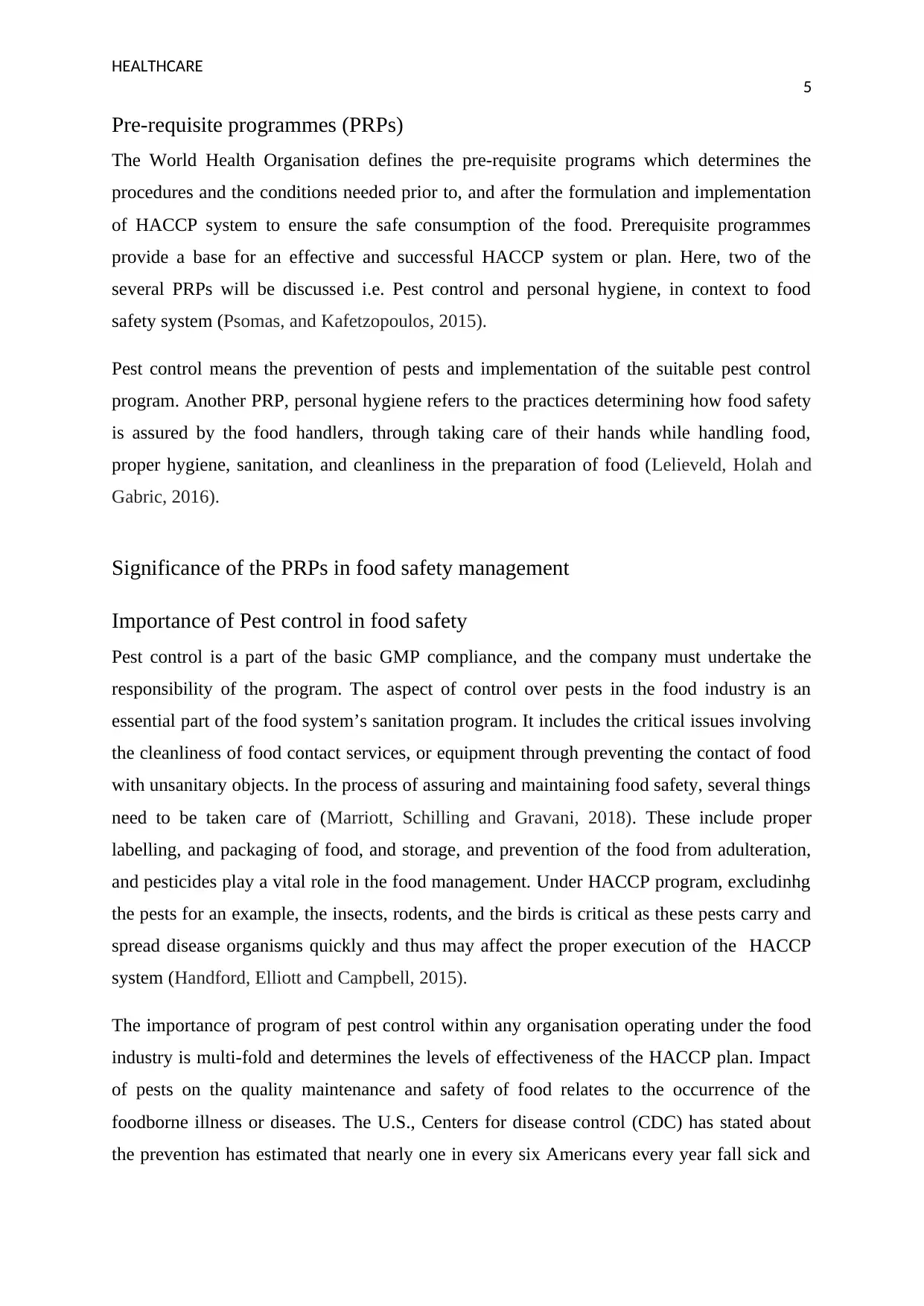
HEALTHCARE
5
Pre-requisite programmes (PRPs)
The World Health Organisation defines the pre-requisite programs which determines the
procedures and the conditions needed prior to, and after the formulation and implementation
of HACCP system to ensure the safe consumption of the food. Prerequisite programmes
provide a base for an effective and successful HACCP system or plan. Here, two of the
several PRPs will be discussed i.e. Pest control and personal hygiene, in context to food
safety system (Psomas, and Kafetzopoulos, 2015).
Pest control means the prevention of pests and implementation of the suitable pest control
program. Another PRP, personal hygiene refers to the practices determining how food safety
is assured by the food handlers, through taking care of their hands while handling food,
proper hygiene, sanitation, and cleanliness in the preparation of food (Lelieveld, Holah and
Gabric, 2016).
Significance of the PRPs in food safety management
Importance of Pest control in food safety
Pest control is a part of the basic GMP compliance, and the company must undertake the
responsibility of the program. The aspect of control over pests in the food industry is an
essential part of the food system’s sanitation program. It includes the critical issues involving
the cleanliness of food contact services, or equipment through preventing the contact of food
with unsanitary objects. In the process of assuring and maintaining food safety, several things
need to be taken care of (Marriott, Schilling and Gravani, 2018). These include proper
labelling, and packaging of food, and storage, and prevention of the food from adulteration,
and pesticides play a vital role in the food management. Under HACCP program, excludinhg
the pests for an example, the insects, rodents, and the birds is critical as these pests carry and
spread disease organisms quickly and thus may affect the proper execution of the HACCP
system (Handford, Elliott and Campbell, 2015).
The importance of program of pest control within any organisation operating under the food
industry is multi-fold and determines the levels of effectiveness of the HACCP plan. Impact
of pests on the quality maintenance and safety of food relates to the occurrence of the
foodborne illness or diseases. The U.S., Centers for disease control (CDC) has stated about
the prevention has estimated that nearly one in every six Americans every year fall sick and
5
Pre-requisite programmes (PRPs)
The World Health Organisation defines the pre-requisite programs which determines the
procedures and the conditions needed prior to, and after the formulation and implementation
of HACCP system to ensure the safe consumption of the food. Prerequisite programmes
provide a base for an effective and successful HACCP system or plan. Here, two of the
several PRPs will be discussed i.e. Pest control and personal hygiene, in context to food
safety system (Psomas, and Kafetzopoulos, 2015).
Pest control means the prevention of pests and implementation of the suitable pest control
program. Another PRP, personal hygiene refers to the practices determining how food safety
is assured by the food handlers, through taking care of their hands while handling food,
proper hygiene, sanitation, and cleanliness in the preparation of food (Lelieveld, Holah and
Gabric, 2016).
Significance of the PRPs in food safety management
Importance of Pest control in food safety
Pest control is a part of the basic GMP compliance, and the company must undertake the
responsibility of the program. The aspect of control over pests in the food industry is an
essential part of the food system’s sanitation program. It includes the critical issues involving
the cleanliness of food contact services, or equipment through preventing the contact of food
with unsanitary objects. In the process of assuring and maintaining food safety, several things
need to be taken care of (Marriott, Schilling and Gravani, 2018). These include proper
labelling, and packaging of food, and storage, and prevention of the food from adulteration,
and pesticides play a vital role in the food management. Under HACCP program, excludinhg
the pests for an example, the insects, rodents, and the birds is critical as these pests carry and
spread disease organisms quickly and thus may affect the proper execution of the HACCP
system (Handford, Elliott and Campbell, 2015).
The importance of program of pest control within any organisation operating under the food
industry is multi-fold and determines the levels of effectiveness of the HACCP plan. Impact
of pests on the quality maintenance and safety of food relates to the occurrence of the
foodborne illness or diseases. The U.S., Centers for disease control (CDC) has stated about
the prevention has estimated that nearly one in every six Americans every year fall sick and
⊘ This is a preview!⊘
Do you want full access?
Subscribe today to unlock all pages.

Trusted by 1+ million students worldwide

HEALTHCARE
6
more than 3,000 people die from a number of food-borne diseases. As different bacteria, or
pathogens can occur contaminating the food or food surface, during the process of
preparation or food handling (Zwietering et al., 2016).
Pest control in design and maintenance of HACCP plan
Prior to the development of HACCP plan, it has found that establishment must implement
pre-requisite programs to develop food safety standards. Thus, pests or insects attack on the
walls, food, or food surfaces controlled. Thus, in other words, prevention of food from
contamination and using effective methods of food packaging will lead to effectiveness of the
HACCP plan. As it will facilitate in conducting an appropriate hazard analysis, which
includes the critical role of the pest control programmes, so as to attain high levels of food
safety and quality (Soman and Raman, 2016).
Importance of /Personal hygiene
The aim of assuring safety and hygiene of food and prevent cross contamination of the food
it has been understood that adherence to the vital standards of personal hygiene must be
maintained by food handlers. The aspect of personal hygiene is crucial on the part or role of
the food handlers, as they need to work towards the prevention of food contamination. As
contaminated food will spread the bacteria around the kitchen very quickly, this will further
affect the safety and quality of food. For an instance, keeping hands clean is the simple act of
ensuring high levels of personal hygiene and ensuring safety. Thus, food businesses need to
prevent the contamination of the food by the hygiene or health issue of the food handlers
(Food safety and quality, 2018).
The food handlers are required to wash their hands properly, and ensure their best health and
must ensure wearing gloves, which will help prevent the food from contamination through
the bare hands. Disease control is one of the major objectives, which can be achieved through
implementation of personal hygiene practices or procedures within an organisation. For
attaining this objective, it has found that food processors do not allow the workers who are
sick or affected by any found in the food-handling environment. Good hygiene practices
(GHP) adopted so that the harvested commodity will not create a food hazard to the customer
(Tomasevic et al., 2016).
6
more than 3,000 people die from a number of food-borne diseases. As different bacteria, or
pathogens can occur contaminating the food or food surface, during the process of
preparation or food handling (Zwietering et al., 2016).
Pest control in design and maintenance of HACCP plan
Prior to the development of HACCP plan, it has found that establishment must implement
pre-requisite programs to develop food safety standards. Thus, pests or insects attack on the
walls, food, or food surfaces controlled. Thus, in other words, prevention of food from
contamination and using effective methods of food packaging will lead to effectiveness of the
HACCP plan. As it will facilitate in conducting an appropriate hazard analysis, which
includes the critical role of the pest control programmes, so as to attain high levels of food
safety and quality (Soman and Raman, 2016).
Importance of /Personal hygiene
The aim of assuring safety and hygiene of food and prevent cross contamination of the food
it has been understood that adherence to the vital standards of personal hygiene must be
maintained by food handlers. The aspect of personal hygiene is crucial on the part or role of
the food handlers, as they need to work towards the prevention of food contamination. As
contaminated food will spread the bacteria around the kitchen very quickly, this will further
affect the safety and quality of food. For an instance, keeping hands clean is the simple act of
ensuring high levels of personal hygiene and ensuring safety. Thus, food businesses need to
prevent the contamination of the food by the hygiene or health issue of the food handlers
(Food safety and quality, 2018).
The food handlers are required to wash their hands properly, and ensure their best health and
must ensure wearing gloves, which will help prevent the food from contamination through
the bare hands. Disease control is one of the major objectives, which can be achieved through
implementation of personal hygiene practices or procedures within an organisation. For
attaining this objective, it has found that food processors do not allow the workers who are
sick or affected by any found in the food-handling environment. Good hygiene practices
(GHP) adopted so that the harvested commodity will not create a food hazard to the customer
(Tomasevic et al., 2016).
Paraphrase This Document
Need a fresh take? Get an instant paraphrase of this document with our AI Paraphraser
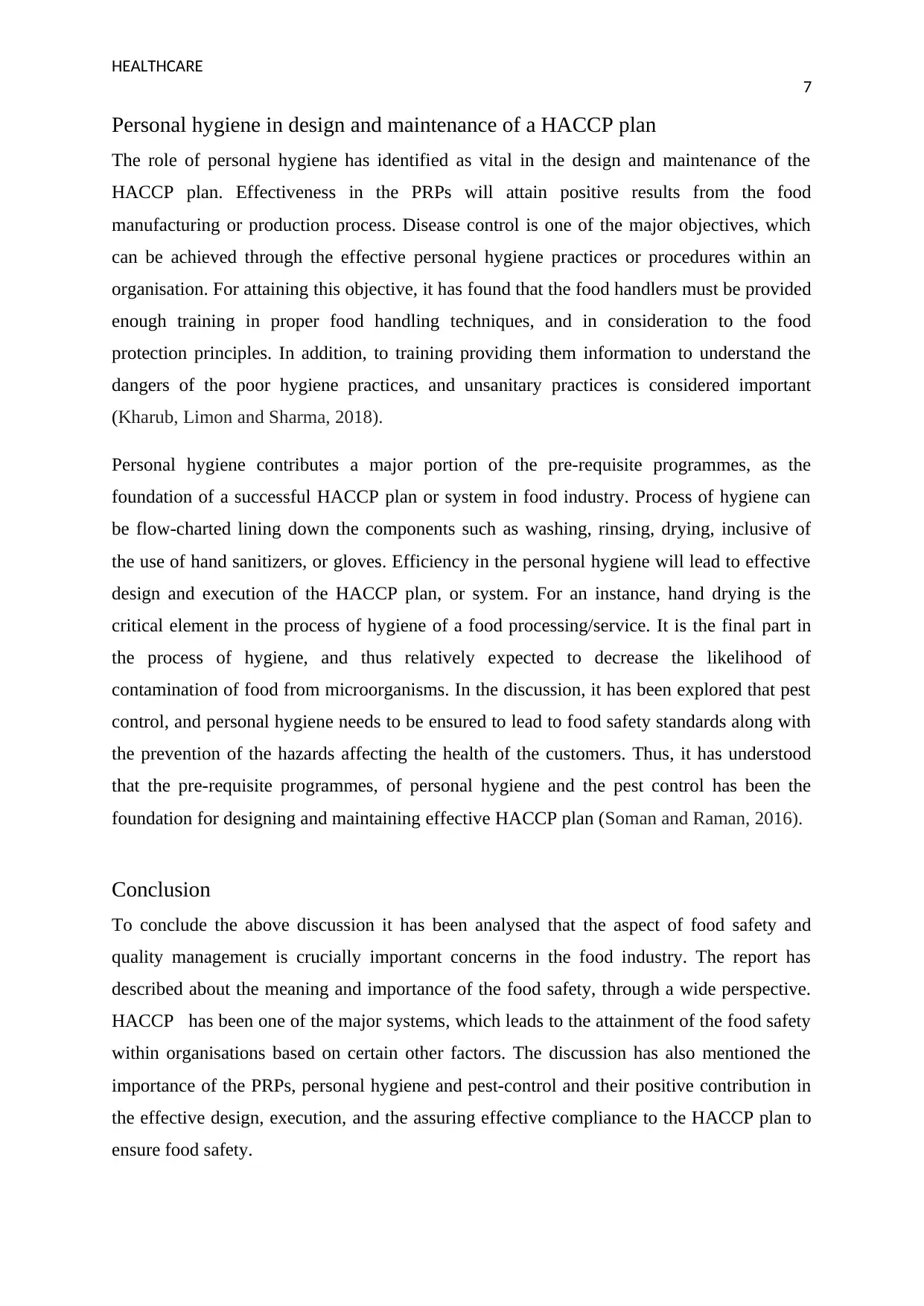
HEALTHCARE
7
Personal hygiene in design and maintenance of a HACCP plan
The role of personal hygiene has identified as vital in the design and maintenance of the
HACCP plan. Effectiveness in the PRPs will attain positive results from the food
manufacturing or production process. Disease control is one of the major objectives, which
can be achieved through the effective personal hygiene practices or procedures within an
organisation. For attaining this objective, it has found that the food handlers must be provided
enough training in proper food handling techniques, and in consideration to the food
protection principles. In addition, to training providing them information to understand the
dangers of the poor hygiene practices, and unsanitary practices is considered important
(Kharub, Limon and Sharma, 2018).
Personal hygiene contributes a major portion of the pre-requisite programmes, as the
foundation of a successful HACCP plan or system in food industry. Process of hygiene can
be flow-charted lining down the components such as washing, rinsing, drying, inclusive of
the use of hand sanitizers, or gloves. Efficiency in the personal hygiene will lead to effective
design and execution of the HACCP plan, or system. For an instance, hand drying is the
critical element in the process of hygiene of a food processing/service. It is the final part in
the process of hygiene, and thus relatively expected to decrease the likelihood of
contamination of food from microorganisms. In the discussion, it has been explored that pest
control, and personal hygiene needs to be ensured to lead to food safety standards along with
the prevention of the hazards affecting the health of the customers. Thus, it has understood
that the pre-requisite programmes, of personal hygiene and the pest control has been the
foundation for designing and maintaining effective HACCP plan (Soman and Raman, 2016).
Conclusion
To conclude the above discussion it has been analysed that the aspect of food safety and
quality management is crucially important concerns in the food industry. The report has
described about the meaning and importance of the food safety, through a wide perspective.
HACCP has been one of the major systems, which leads to the attainment of the food safety
within organisations based on certain other factors. The discussion has also mentioned the
importance of the PRPs, personal hygiene and pest-control and their positive contribution in
the effective design, execution, and the assuring effective compliance to the HACCP plan to
ensure food safety.
7
Personal hygiene in design and maintenance of a HACCP plan
The role of personal hygiene has identified as vital in the design and maintenance of the
HACCP plan. Effectiveness in the PRPs will attain positive results from the food
manufacturing or production process. Disease control is one of the major objectives, which
can be achieved through the effective personal hygiene practices or procedures within an
organisation. For attaining this objective, it has found that the food handlers must be provided
enough training in proper food handling techniques, and in consideration to the food
protection principles. In addition, to training providing them information to understand the
dangers of the poor hygiene practices, and unsanitary practices is considered important
(Kharub, Limon and Sharma, 2018).
Personal hygiene contributes a major portion of the pre-requisite programmes, as the
foundation of a successful HACCP plan or system in food industry. Process of hygiene can
be flow-charted lining down the components such as washing, rinsing, drying, inclusive of
the use of hand sanitizers, or gloves. Efficiency in the personal hygiene will lead to effective
design and execution of the HACCP plan, or system. For an instance, hand drying is the
critical element in the process of hygiene of a food processing/service. It is the final part in
the process of hygiene, and thus relatively expected to decrease the likelihood of
contamination of food from microorganisms. In the discussion, it has been explored that pest
control, and personal hygiene needs to be ensured to lead to food safety standards along with
the prevention of the hazards affecting the health of the customers. Thus, it has understood
that the pre-requisite programmes, of personal hygiene and the pest control has been the
foundation for designing and maintaining effective HACCP plan (Soman and Raman, 2016).
Conclusion
To conclude the above discussion it has been analysed that the aspect of food safety and
quality management is crucially important concerns in the food industry. The report has
described about the meaning and importance of the food safety, through a wide perspective.
HACCP has been one of the major systems, which leads to the attainment of the food safety
within organisations based on certain other factors. The discussion has also mentioned the
importance of the PRPs, personal hygiene and pest-control and their positive contribution in
the effective design, execution, and the assuring effective compliance to the HACCP plan to
ensure food safety.
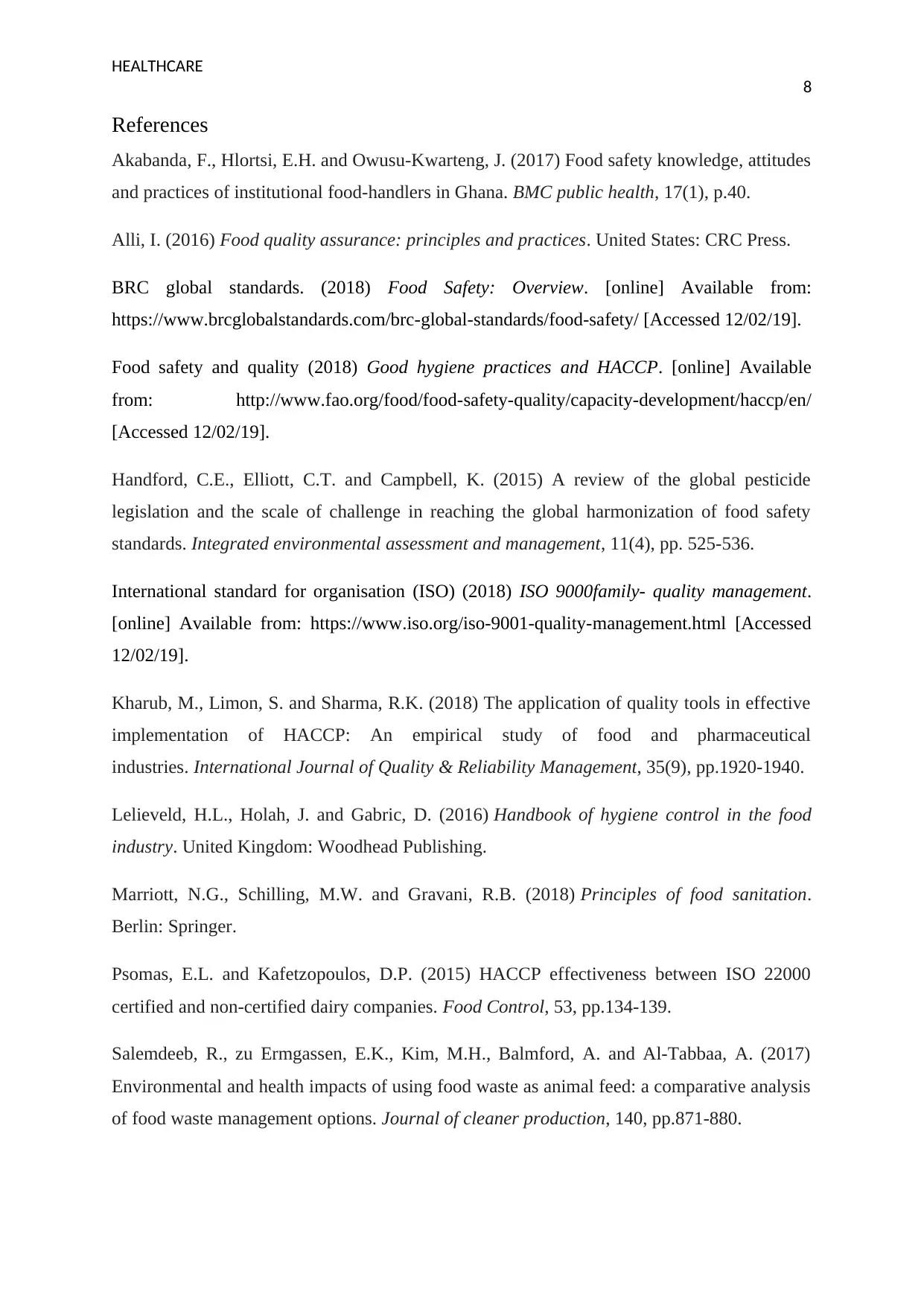
HEALTHCARE
8
References
Akabanda, F., Hlortsi, E.H. and Owusu-Kwarteng, J. (2017) Food safety knowledge, attitudes
and practices of institutional food-handlers in Ghana. BMC public health, 17(1), p.40.
Alli, I. (2016) Food quality assurance: principles and practices. United States: CRC Press.
BRC global standards. (2018) Food Safety: Overview. [online] Available from:
https://www.brcglobalstandards.com/brc-global-standards/food-safety/ [Accessed 12/02/19].
Food safety and quality (2018) Good hygiene practices and HACCP. [online] Available
from: http://www.fao.org/food/food-safety-quality/capacity-development/haccp/en/
[Accessed 12/02/19].
Handford, C.E., Elliott, C.T. and Campbell, K. (2015) A review of the global pesticide
legislation and the scale of challenge in reaching the global harmonization of food safety
standards. Integrated environmental assessment and management, 11(4), pp. 525-536.
International standard for organisation (ISO) (2018) ISO 9000family- quality management.
[online] Available from: https://www.iso.org/iso-9001-quality-management.html [Accessed
12/02/19].
Kharub, M., Limon, S. and Sharma, R.K. (2018) The application of quality tools in effective
implementation of HACCP: An empirical study of food and pharmaceutical
industries. International Journal of Quality & Reliability Management, 35(9), pp.1920-1940.
Lelieveld, H.L., Holah, J. and Gabric, D. (2016) Handbook of hygiene control in the food
industry. United Kingdom: Woodhead Publishing.
Marriott, N.G., Schilling, M.W. and Gravani, R.B. (2018) Principles of food sanitation.
Berlin: Springer.
Psomas, E.L. and Kafetzopoulos, D.P. (2015) HACCP effectiveness between ISO 22000
certified and non-certified dairy companies. Food Control, 53, pp.134-139.
Salemdeeb, R., zu Ermgassen, E.K., Kim, M.H., Balmford, A. and Al-Tabbaa, A. (2017)
Environmental and health impacts of using food waste as animal feed: a comparative analysis
of food waste management options. Journal of cleaner production, 140, pp.871-880.
8
References
Akabanda, F., Hlortsi, E.H. and Owusu-Kwarteng, J. (2017) Food safety knowledge, attitudes
and practices of institutional food-handlers in Ghana. BMC public health, 17(1), p.40.
Alli, I. (2016) Food quality assurance: principles and practices. United States: CRC Press.
BRC global standards. (2018) Food Safety: Overview. [online] Available from:
https://www.brcglobalstandards.com/brc-global-standards/food-safety/ [Accessed 12/02/19].
Food safety and quality (2018) Good hygiene practices and HACCP. [online] Available
from: http://www.fao.org/food/food-safety-quality/capacity-development/haccp/en/
[Accessed 12/02/19].
Handford, C.E., Elliott, C.T. and Campbell, K. (2015) A review of the global pesticide
legislation and the scale of challenge in reaching the global harmonization of food safety
standards. Integrated environmental assessment and management, 11(4), pp. 525-536.
International standard for organisation (ISO) (2018) ISO 9000family- quality management.
[online] Available from: https://www.iso.org/iso-9001-quality-management.html [Accessed
12/02/19].
Kharub, M., Limon, S. and Sharma, R.K. (2018) The application of quality tools in effective
implementation of HACCP: An empirical study of food and pharmaceutical
industries. International Journal of Quality & Reliability Management, 35(9), pp.1920-1940.
Lelieveld, H.L., Holah, J. and Gabric, D. (2016) Handbook of hygiene control in the food
industry. United Kingdom: Woodhead Publishing.
Marriott, N.G., Schilling, M.W. and Gravani, R.B. (2018) Principles of food sanitation.
Berlin: Springer.
Psomas, E.L. and Kafetzopoulos, D.P. (2015) HACCP effectiveness between ISO 22000
certified and non-certified dairy companies. Food Control, 53, pp.134-139.
Salemdeeb, R., zu Ermgassen, E.K., Kim, M.H., Balmford, A. and Al-Tabbaa, A. (2017)
Environmental and health impacts of using food waste as animal feed: a comparative analysis
of food waste management options. Journal of cleaner production, 140, pp.871-880.
⊘ This is a preview!⊘
Do you want full access?
Subscribe today to unlock all pages.

Trusted by 1+ million students worldwide
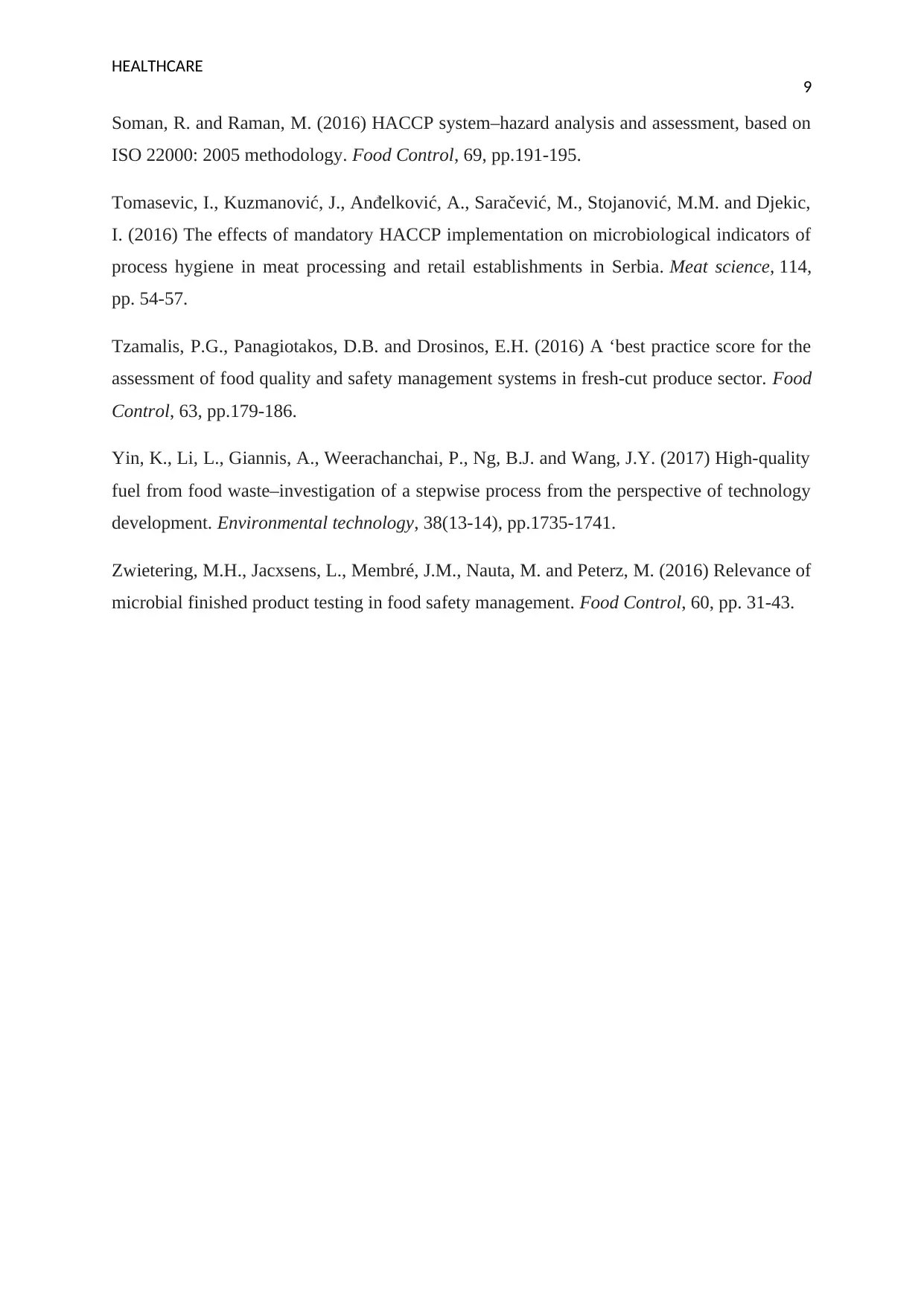
HEALTHCARE
9
Soman, R. and Raman, M. (2016) HACCP system–hazard analysis and assessment, based on
ISO 22000: 2005 methodology. Food Control, 69, pp.191-195.
Tomasevic, I., Kuzmanović, J., Anđelković, A., Saračević, M., Stojanović, M.M. and Djekic,
I. (2016) The effects of mandatory HACCP implementation on microbiological indicators of
process hygiene in meat processing and retail establishments in Serbia. Meat science, 114,
pp. 54-57.
Tzamalis, P.G., Panagiotakos, D.B. and Drosinos, E.H. (2016) A ‘best practice score for the
assessment of food quality and safety management systems in fresh-cut produce sector. Food
Control, 63, pp.179-186.
Yin, K., Li, L., Giannis, A., Weerachanchai, P., Ng, B.J. and Wang, J.Y. (2017) High-quality
fuel from food waste–investigation of a stepwise process from the perspective of technology
development. Environmental technology, 38(13-14), pp.1735-1741.
Zwietering, M.H., Jacxsens, L., Membré, J.M., Nauta, M. and Peterz, M. (2016) Relevance of
microbial finished product testing in food safety management. Food Control, 60, pp. 31-43.
9
Soman, R. and Raman, M. (2016) HACCP system–hazard analysis and assessment, based on
ISO 22000: 2005 methodology. Food Control, 69, pp.191-195.
Tomasevic, I., Kuzmanović, J., Anđelković, A., Saračević, M., Stojanović, M.M. and Djekic,
I. (2016) The effects of mandatory HACCP implementation on microbiological indicators of
process hygiene in meat processing and retail establishments in Serbia. Meat science, 114,
pp. 54-57.
Tzamalis, P.G., Panagiotakos, D.B. and Drosinos, E.H. (2016) A ‘best practice score for the
assessment of food quality and safety management systems in fresh-cut produce sector. Food
Control, 63, pp.179-186.
Yin, K., Li, L., Giannis, A., Weerachanchai, P., Ng, B.J. and Wang, J.Y. (2017) High-quality
fuel from food waste–investigation of a stepwise process from the perspective of technology
development. Environmental technology, 38(13-14), pp.1735-1741.
Zwietering, M.H., Jacxsens, L., Membré, J.M., Nauta, M. and Peterz, M. (2016) Relevance of
microbial finished product testing in food safety management. Food Control, 60, pp. 31-43.
1 out of 10
Related Documents
Your All-in-One AI-Powered Toolkit for Academic Success.
+13062052269
info@desklib.com
Available 24*7 on WhatsApp / Email
![[object Object]](/_next/static/media/star-bottom.7253800d.svg)
Unlock your academic potential
Copyright © 2020–2025 A2Z Services. All Rights Reserved. Developed and managed by ZUCOL.





